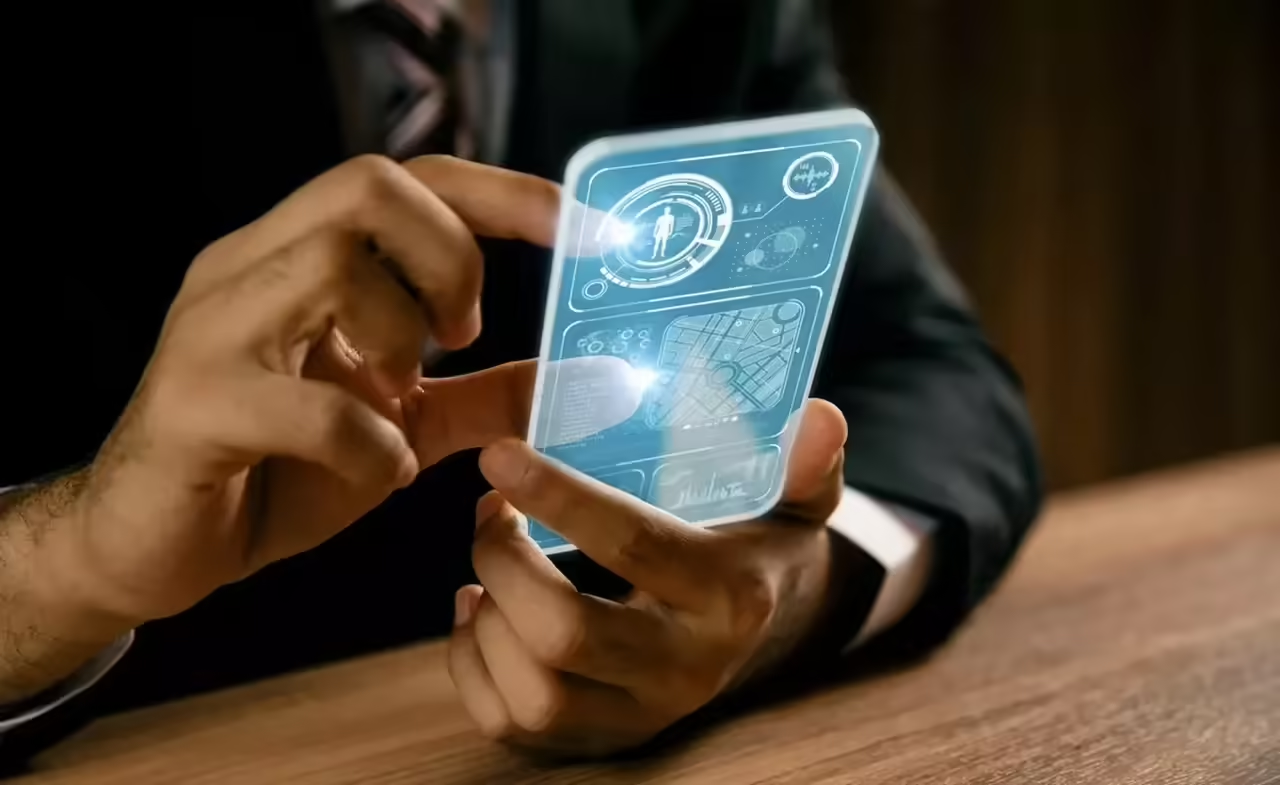
It is difficult to predict with certainty what smartphones will look like in 100 years, as technological advances are always changing at a rapid pace and new innovations can revolutionize the way we interact with our devices. However, based on current trends, technological advances and artificial intelligence, we can make some guesses about what the future smartphone might look like. Here are some possible scenarios:
Design
Smartphones could be even thinner and lighter than they are today, and possibly even become transparent or foldable. The screen could be projected onto any surface or even a person’s retina, rendering physical screens obsolete. In addition, smartphones could become more personalized in their design, with users being able to choose from a variety of shapes, sizes and colors.
Hardware
One of the most significant advances in smartphone technology could be the use of quantum computing. With quantum computing, the processing power of smartphones could increase exponentially, allowing much more complex tasks to be performed at much faster speeds. Batteries could become more efficient, last longer and charge faster. Cameras could become even more advanced, potentially using advanced software to create augmented or virtual reality experiences.
Software
Artificial intelligence (AI) is already transforming the smartphone experience, and in 100 years, AI is likely to become even more sophisticated. Smartphones could be equipped with advanced personal assistants that anticipate users’ needs and make recommendations accordingly. Virtual and augmented reality could be more seamlessly integrated into everyday life, with smartphones acting as the primary portal for these experiences. In addition, advanced security measures could be developed to protect users’ data and privacy.
Connectivity
The future of smartphone connectivity is likely to be even more advanced than it is today. 5G and 6G technology will likely be standard, enabling faster upload and download speeds. Even more exciting, however, is the potential for direct brain-to-device communication, which would allow users to control their devices with their thoughts alone.
Sustainability
In 100 years, environmental concerns will likely be even more pressing than they are today, and smartphone manufacturers will need to address these concerns in their products. Smartphones could be made from sustainable materials, and companies could prioritize recycling and waste reduction.
Overall, it is difficult to predict exactly what smartphones will look like in 100 years, but it is clear that they will continue to evolve and become more advanced. They are likely to become even more integrated into our daily lives and provide us with even more personalized and immersive experiences.
Smartphone materials in 100 years
It is difficult to predict with certainty what materials will be used to make smartphones 100 years from now, as technological advances and new discoveries may lead to new materials that we may not even be aware of today. However, based on current trends and ongoing research, here are some potential materials that could be used:
Graphene
Graphene is a thin, lightweight, flexible material that is stronger than steel, but is also a good conductor of heat and electricity. It could potentially replace traditional materials such as silicon, copper and aluminum that are commonly used in electronics.
Authored materials for repair
In the future, smartphones could be made with self-repairing materials that repair themselves when damaged. This would help extend the life of the phone and reduce the amount of e-waste.
Biodegradable materials
Environmental concerns are likely to become increasingly important in the future, and smartphone manufacturers could prioritize the use of biodegradable materials. These materials would naturally decompose over time, reducing the environmental impact of e-waste.
Nanomaterials
In the future, smartphones could be made from nano materials, which are extremely small and have unique properties. These materials could be used to make smaller, more powerful and energy-efficient devices.
Advanced ceramics
Ceramics have high melting points, making them ideal for use in high-temperature environments such as electronics. In the future, advanced ceramics could be developed that are stronger, more durable and better at conducting heat than today’s ceramics.
These are just a few potential materials that could be used to make smartphones in 100 years. It is important to keep in mind that these materials are not yet widely used or fully developed, so the future of smartphone materials could look very different from what we can currently imagine.
Could smartphones simply be a chip implanted in the eye?
It is possible that in the future, smartphones could be integrated into the human body in some way, such as through implantable chips or other devices. However, there are many ethical, social, and technical challenges that must be addressed before such technology can become widespread.
One of the biggest concerns with implantable devices is the possibility of loss of privacy and autonomy. If a device is implanted in the body, it could potentially be used to track an individual’s movements or monitor his or her behavior, raising questions about personal liberty and civil liberties. In addition, there could be health risks associated with implantable devices, such as the risk of infection, rejection by the body, or interference with other medical devices.
In addition, the technical challenges associated with implantable devices are significant. For example, it would be difficult to create an implantable device that could provide the same level of functionality as a traditional smartphone, including a high-quality display, processing power and battery life. In addition, there could be challenges with connecting an implantable device to other devices or networks, particularly given the rapidly evolving nature of wireless communications technology.
Overall, while it is possible that smartphones could one day be integrated into the human body, such technology is likely still many years or even decades away. In the meantime, we can expect to see a continued evolution in smartphone technology, with more advanced software, hardware and design that will continue to transform the way we interact with technology.
Is it possible that they will no longer exist and will be replaced by some other type of device?
It is quite possible that smartphones as we know them today will become obsolete and be replaced by other types of devices in the future. This is because technology is constantly evolving and new and more advanced devices are being developed all the time.
For example, wearable technology such as smartwatches, augmented reality (AR) glasses and virtual reality (VR) headsets are already becoming more popular, and it is possible that these types of devices will eventually replace smartphones as our primary means of communication and computing. In fact, some experts predict that AR glasses could become the next big breakthrough in technology, offering a more immersive and intuitive way to interact with technology.
Other potential replacements for smartphones include brain-computer interfaces (BCIs) and other implantable or wearable devices that enable more direct and intuitive communication with technology. These types of devices could offer new levels of control and integration with the digital world, and could make smartphones obsolete.
Of course, it is impossible to predict exactly what the future of technology will look like, and it is likely that new and unexpected developments will continue to emerge. However, it is safe to say that the technology we use to communicate and access information will continue to evolve and transform in ways we cannot yet imagine.
So what could cell phones look like a century from now? It’s hard to predict with certainty, but here are some possible trends that could shape cell phone technology in the next 100 years.
Greater integration with our bodies: It is possible that cell phones in the future will be more integrated with our bodies. Instead of having to pull out our phone to send a message or make a call, we could have devices that are implanted in our skin that allow us to interact with the technology without the need to use our hands.
Interacting with the environment: Mobile phones in the future could be equipped with advanced sensors that allow them to interact with the environment in ways we have never before imagined. They could detect the temperature and humidity of the air, the level of pollution, and even our precise location in space.
Augmented reality: Augmented reality (AR) technology is already present in some mobile devices, but in 100 years, we could expect to see an even more advanced form of AR. Cell phones could offer a full augmented reality experience that not only allows us to see information about the world around us, but can also transform our reality into a whole new experience.
Instant communication: In 100 years, we could expect communication to be more instantaneous than ever before. Cell phones could be equipped with technology that allows us to communicate with anyone anywhere in the world without the need to wait for an internet signal to reach our device.
Sustainable energy: Sustainable energy technology could play an important role in how the cell phones of the future are powered. Instead of relying on batteries that need to be recharged regularly, cell phones could be powered by sunlight or other means of renewable energy.
Advanced artificial intelligence: In 100 years, cell phones could be equipped with advanced artificial intelligence that enables them to understand and adapt to our needs and preferences. They could be able to anticipate our needs before we ask for them, and adjust their functions and settings accordingly.
Mind control: Instead of having to touch or talk to our phone to interact with it, we might be able to control our device with our thoughts. This technology is still at an early stage of development, but could be possible in the future.
New forms of communication: Instead of relying on voice and text to communicate, cell phones could allow us to communicate through other forms of signals, such as telepathy or thought transmission. Although it sounds futuristic, research in these fields is already underway.







